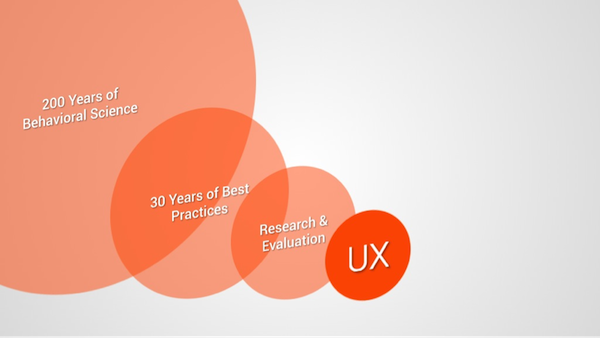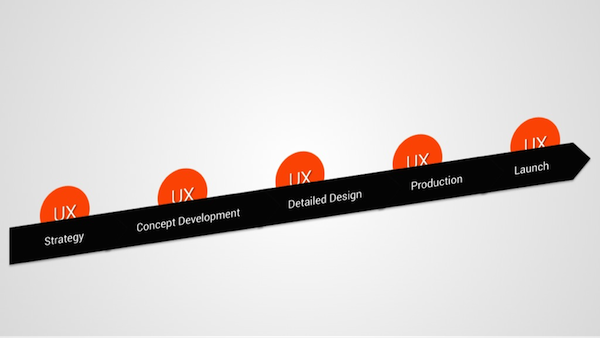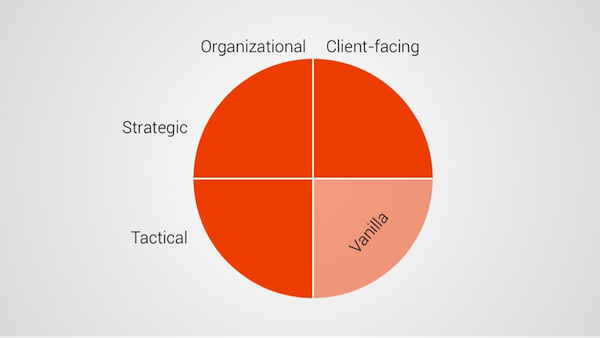While the concept of user experience and the term UX have become seemingly ubiquitous in the workplace, most non-UX people still have the wrong idea about what it is.
Here are four common UX myths and how we can bust them.
Myth: UX is too Soft; it’s not Based on Anything
One of the most annoying things people say about UX is that it’s “just common sense,” or it’s “something you just made up.” Nothing could be further from the truth: UX is based on 200 years of scientific knowledge, 30 years of industry best practices, and specifically applied research.
Firstly, UX has a deep scientific heritage. Because we study and influence the way people use artifacts and carry out tasks, the field’s roots are in the behavioral sciences, specifically ergonomics, psychology, and human factors.
The Industrial Revolution made it necessary (and profitable) to start thinking about how people could create tools so that factory workers could use them as efficiently as possible. This drive spawned the field of ergonomics, a term Wojciech Jastrzebowski coined in 1857. At the same time, other scientists were studying how people think, how we cognitively process tasks, and what motivates us: Wilhelm Wundt founded the first psychology lab in 1879.
World War I and the rising importance of cars and airplanes allowed another field to emerge: human factors. This takes methodologies and insights from both ergonomics and psychology to understand how people behave while using complex tools and in different environments.
Secondly next to its scientific roots, the UX field itself has been around long enough to have developed its own best practices. Indeed, Don Norman popularized the term “user experience” while working at Apple in the 1990’s, and companies like Xerox were conducting formal research on computer-human interaction before that. In fact, Jakob Nielsen wrote his famous 10 usability heuristics in 1995, which we still use today.
UX knowledge and methods come from centuries of academic study, practice, and applied research.
Finally, the UX field sets itself apart from most other professional disciplines through its cornerstone of built-in, methodological evaluation. We practitioners all evaluate our craft in some way with real users, because user testing is intrinsic to the UX process. We also share these insights with each other through a diverse ecosystem of conferences and publications.
In other words, behind every well-trained UX professional is 200 years of academic knowledge, 30 years of practical experience, and a dose of process-intrinsic user research.
Myth: Anyone can do UX
Lots of people, from managers to engineers, think that anyone can “do UX” by reading a book or two and subscribing to UX Magazine. While it’s a seductive idea, a successful product team enjoys a balanced creative tension between stakeholders. If non-UX stakeholders try to “do UX,” such creative tension no longer exists, and product teams then neglect important aspects of the product.
Managers and business stakeholders generally excel at making money and leading teams. However, business goals stand, almost by definition, in opposition to user needs. If the UX representative in a project is too business-focused, the product will leave user needs unfulfilled.
Visual designers amaze us by creating beauty in all things, but their responsibility lies in pushing the envelope and being crazy innovative, which means that they often need to disregard the limits imposed by information architecture or usability. If the UX person is too focused on visual design, the product will be super-sexy but useless.
Engineers, builders, or technical stakeholders master the craft of making things work. They are focused on ensuring the product is as simple and efficient as possible, so that it works correctly and reliably. Where the UX person is too technology-focused, the product will be technical marvel that users find meaningless or unusable.
Each of these types of stakeholders is responsible for safeguarding a certain perspective, and the UX practitioner works in the middle of all of them, fostering a healthy creative tension and balancing all of these different perspectives (not only against user needs, but also against each other). In addition to that, the UX person needs to evangelize UX sensibility within the team and engender empathy between stakeholders.
If this evangelism is successful, the whole team becomes UX-savvy: managers learn to communicate problems, rather than trying to devise solutions. Visual designers learn to think beyond how something looks and consider how it works and behaves. Engineers learn to challenge the team by anticipating extra use cases and communicating technical opportunities.
Myth: UX is too Expensive
It’s true that the best way to integrate UX in an organization is to have full-time UX support at all phases of the design process. However, that’s not always practical. Employing UX methods surgically, especially by using guerrilla-style methods, can maximize benefit while minimizing cost. Don’t be scared of “light” UX in lieu of “full-on” UX. Something is better than nothing at all.
When creating on a budget, pick and choose where UX expertise can best support your process. While crafting a strategy, consider letting a UX person interview stakeholders, facilitate work sessions for requirements gathering, and/or do some consumer journey mapping. UX people can help during concept development by creating demos, challenging the concept with the requirements, or ideating from a consumer’s perspective.
Detailed design benefits from UX input the most in the form of rapid prototyping, light field testing, and evaluating visual design from the perspectives of information architecture and technical feasibility. Once a product goes into production, a UX practitioner can clarify requirements to engineers or fill any gaps in unforeseen use cases (i.e. “What should happen if the user does X?”). After product launch, a UX person can help re-iterate requirements, set up an evaluation and analytics strategy, or facilitate the creation of product roadmaps from a user-needs perspective.
Of course, it’s best when there is UX involvement at every phase of the process, but we can also add value when brought in at specific moments.
Myth: UX Is Just Interaction Design
When most people think of UX, they think of user flows (boxes and arrows) and wireframes. That’s just the tip of the iceberg, however. User experience methods and knowledge can add value not only to consumer-facing products, but also to an organization’s core business and strategy.
For explanation’s sake, imagine a 2×2 matrix. The essence of anything an organization does (if it has consumers) can be split across that matrix’s four cells. One axis splits organizational activities and consumer-facing activities. The other axis differentiates these activities across two levels: strategic and tactical.
Organizational activities affect the organization itself, while consumer-facing activities affect consumers directly. Strategic activities have long-term effects and usually take longer (long effort, lasting benefit), while tactical activities acutely affect specific things in the short term (short effort, immediate benefit).
Most people only know the tactical, consumer-facing side of UX. These activities are things like interaction design, user testing, and persuasion design. This is vanilla UX, and it’s great, but there’s much more value to be added elsewhere.
Some also know the strategic, consumer-facing side of UX. This encompasses activities like service design, content strategy, and communication strategy. While these activities have greater impact than vanilla UX, they still do not add as much value as real hardcore UX.
Hardcore UX begins with tactical, organizational activities. Big gains start coming when an organization leverages design-thinking and a user experience mindset through knowledge sessions, co-design sessions, and organizational research. Internal UX people or external consultants can carry out these activities.
However, the deepest, most lasting value that UX knowledge and methods can add to an organization is through strategic, organizational activities. Think of organizational (re)structuring, co-creating organizational culture, and creative development of strategic business roadmaps. This is how an organization can let UX into its core, and some large corporations are doing this with great success.
Most people only see vanilla UX, but they are missing out on the many layers of value that UX can add to their organizations by learning, trusting, and accepting empathy at all levels.
Truth: UX is More (Powerful) than You Think
UX knowledge and methods come from centuries of academic study, practice, and applied research. UX requires a healthy balance and some creative tension in teams to work, so there shouldn’t be other stakeholders trying to “do UX.” Taking advantage of UX is only as expensive as you make it; consider applying it surgically to one or several aspects of your project. But don’t forget that the real benefit of UX knowledge comes from using it to design empathy into every aspect of your organization.











